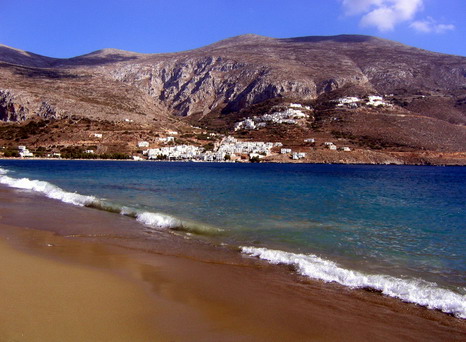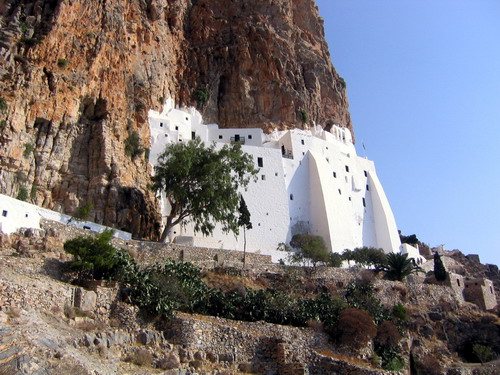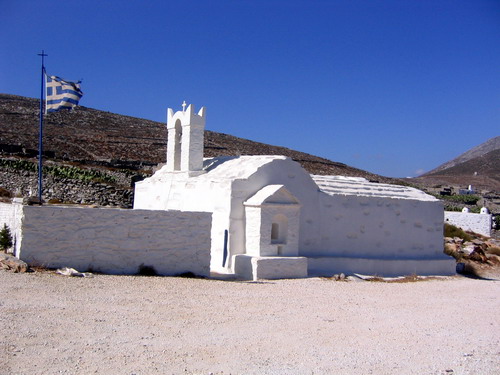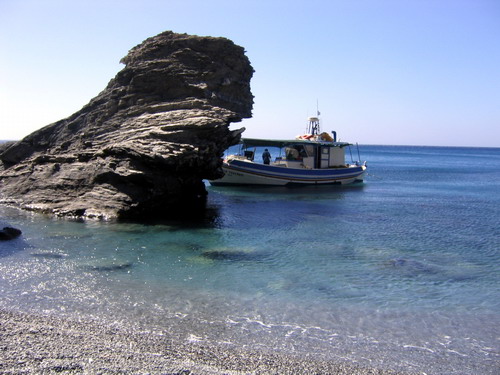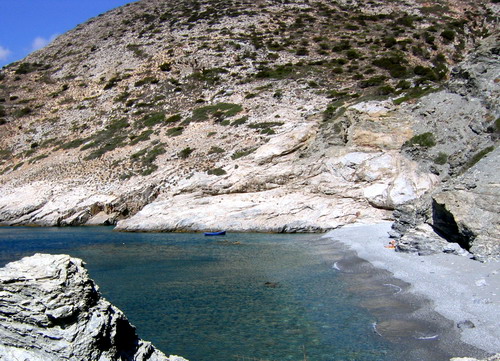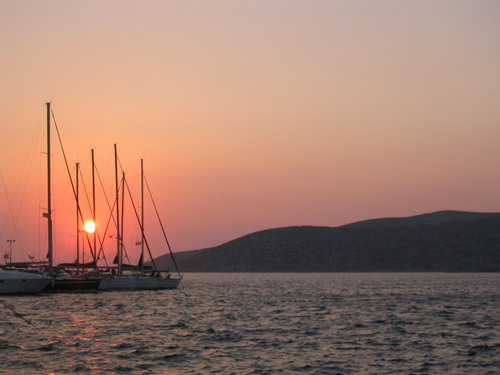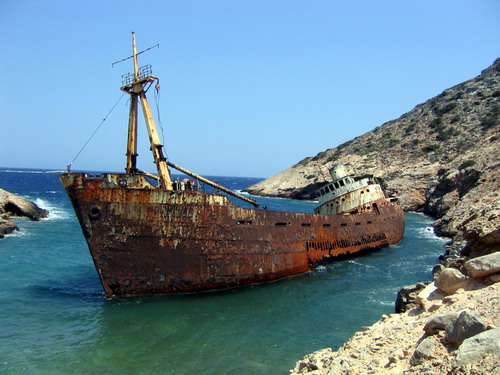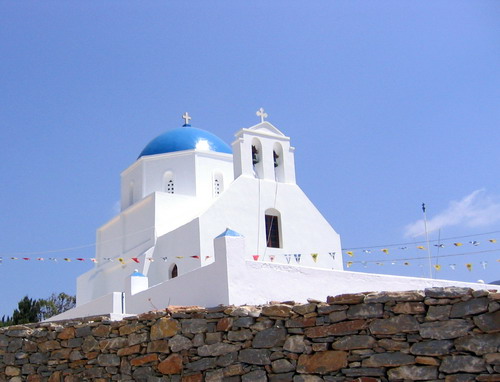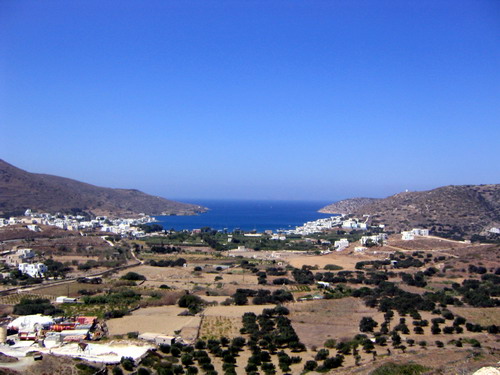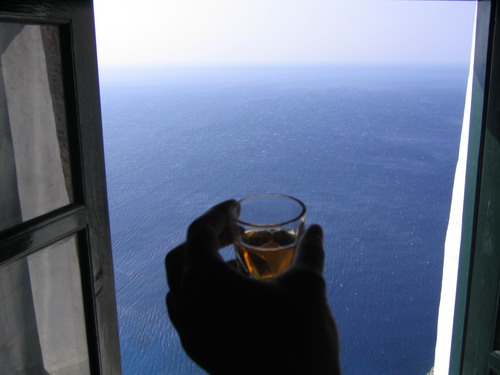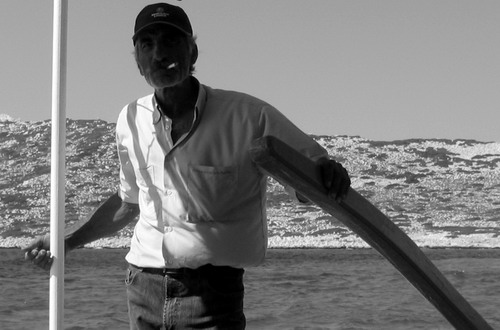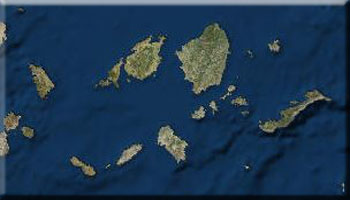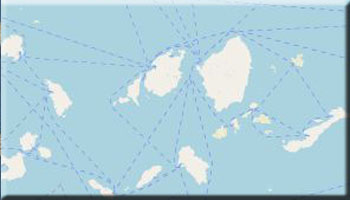Amorgos, the "big blue", is located at the southeastern end of the Cyclades island group, between Naxos, the Small Cyclades, and Astypalaia. It's the natural gateway and link between the Cyclades and the Dodecanese islands. Amorgos is 136 nautical miles from Piraeus. It's capsule-shaped: the island is 18 miles long and 1.5 miles wide at its narrowest and 5 miles wide at its broadest.
The island's two natural harbors - Katapola in the center of the island and Aegiali at its northern end - serve as ports, although much of its 112 - kilometer coastline is craggy cliffs that plunge into sea. The island's highest peak, Krouellos, rises to 821 meters and is located at the island's northern end, above Aegiali. Here, the mountainous terrain is rockier and steeper.
Amorgos has two other peaks - Profitis Ilias (698 meters) in the middle of the island and Aspro Vouno (or Vouno or Korakas, 639 meters) on the west. Small valleys and plains laying between these three peaks harbor settlements like Kolofanas on the west, Katapola in the center, Aegiali in the north, as well as smaller ones like Kamari, Arkessini, and Ayios Pavlos.
Amorgos shares the same geological history with the other islands in the Cyclades group. The oldest rock formations are slate and the newest the limestone, which between them cover most of the land. The island's current shape is roughly 700,000 years old and was set with the sinking of large sections of its interior and the formation of its mountain masses.
The island's flora is typical of the Cyclades; vegetation is sparse, mostly shrubs with mastic shrubs, kermes oak, broom, and scrub (phrygana) beyond the fertile plains at Katapola, Kato Meria, and Aegiali that are thick with olive groves and other fruit - bearing trees. Vines, top quality vegetables, and some cereals are cultivated on terraced fields throughout the island. What the island lacks in size and in the density of its vegetation, it makes up for with the diversity of endemic flora, especially rare herbs with medicinal properties.
The climate on Amorgos is mild and similar to that of the other Cyclades. Aegiali is quite warm in summer because its basin-like shape shields it from the cooling northerly winds, or meltemia.
Known in antiquity as Pagali, Psychia, Karkissia, and Melania, Amorgos had three cities: Arkessini, Minoa, and Aegiali. Based on works by ancient geographers and lexicographers, these cities have been identified respectively as being located at Kastri, Moudalia in Katapola, and Vigla at Tholaria. Archaeological finds indicate Amorgos was first settled in the fifth millennium B.C. and suggest links in antiquity with Naxos, Paros, and more remote islands.
Evidence of the Cycladic culture, with its familiar marble figurines, dates from the third millennium B.C. There are also signs of Minoan influence, while the island was subsequently colonized by Miletus and Naxos. Amorgos was a member of the first Athenian League or Athenian Confederacy. In the third and second centuries B.C., the island found itself under the dominion of the Macedonians, the Ptolemies, the Samians, the Rhodians, and the Romans, yet Hellenistic worship rituals predominate through the fourth century A.D. when ancient temples are converted to Christian places of worship. Later, raids by Saracen pirates force the population to retreat inland and barricade themselves inside settlements at Kastro, Kastri, and in the 23 watchtowers whose remains can be seen around the island.
The icon of the Virgin Hozoviotissa, which is believed to have miracle - making powers, arrived on the island from Palestine during the iconomachy, the period when icons were rejected as encouraging idolatry. Extensive renovations to the monastery in 1088 were made under the Byzantine Emperor Alexis Comnenus.
Venetian rule followed. Architectural vestiges of this era include the Gavras tower (o pyrgos tou Gavra), Kato Lakkos, and the stone - paved Lozes.
This period is followed by Turkish rule, during which Amorgos reaches its economic peak and experiences an ecclesiastic renaissance. In 1822, following the Greek independence revolt, the island becomes the seat of an eparchy of the nascent modern Greek state. Seven years later, in 1829, one of the first Greek schools is established with funds from the Monastery of Panayia Hozoviotissa.
The island's population dwindled in the wake of World War II as large numbers of islanders migrate to urban areas or abroad. In the last two decades, the island has experienced a rapid growth in tourism.
Hora
In Hora, the island's capital, the architecture merges classic Cycladic elements with a rich historical tradition. Strolling the cobblestone passages framed by white - washed churches and two-story mansions or exploring the gently sloped hillsides dotted with windmills overlooking the Aegean are one of the charming pastimes. Every lane in Hora leads to a paved quad known on as the Loza or to the Kastro (castle) perched atop a crag in the settlement's center. Archaeological finds recovered from excavations around the island are exhibited at the former Gavras mansion.
Monastiri
The Monastery of Panayia Hozoviotissa has a timeless beauty. It's also an important religious and historical landmark, noted for its unique architecture and an important collection of historical relics.
Katapola
Katapola is a sheltered natural harbor ringed by three settlements - Katapola, Xylokeratidi, and Rahidi. An imposing hill rising over the harbor has been identified as the site of ancient Minoa, and excavations have yielded a number of important finds. Just beyond is Lefka, one of the island's most charming areas. Katapola's picturesque landscape offers a mix of spare Cycladic architecture, historic churches, pretty beaches dotted with fishing boats, and a lush rolling plain thick with olive trees and vegetable gardens. A range of accommodations and shops are clustered around the port. Katapola offers good anchorage for small fishing boats and leisure craft.
Kato Meria
Kamari and Vroutsi, the two main villages of the Kato Meria (Lower Side) area are located 12 kilometers northwest of Hora. Agios Nicholas, a church with local historical significance, Kastri, the ancient acropolis of Arkesini and the gorgeous beach of Mouros are located here. Just past these two villages are a number of smaller settlements built at the foot of rolling slopes. These are Arkessini, Rahoula, Kolofana, Kalotairitissa, and Mavri Myti. Local sights include the ancient tower of Ayia Triada (Holy Trinity) at Arkesini, the church of Panayia tou Politi at Kolofana, and the church of Ayia Paraskevi, whose paniyiri (religious and folk feast) on July 26 attracts pilgrims from around the island. Kato Meria preserves its traditional economy, which is rooted in farming and livestock keeping.
Aegiali
Aegiali, at the northern end of Amorgos, is a pretty bay formed by sand beaches. Three villages - Lagada, Tholaria, and Potamos - perch on the slopes of the mountains that form its basin. Ormos, the picturesque port, is the area's primary tourist resort and offers a range of amenities and services. The village of Potamos perches atop a hill above the port, offering a panoramic view of the land and sea below - and the most glorious Aegean sunsets on the island. Langada overlooks Aegiali's small plain. It's marked by a series of old windmills, while the Araklos canyon, the fortified church of Ayia Triada (Holy Trinity), the church of Panohoriani, and the old settlement of Stroumbos are sights worth exploring. From Langada, a stone - paved footpath marks a mild hiking trail that leads through a Natura 2000-protected natural landscape to the Byzantine - era Monastery of Ayios Ioannis Theologos and, further north, to the Stavros (Crucifixion) chapel over a disused bauxite mine. Tholaria, which also offers gorgeous views over the coast, are located near Vigla, site of ancient Aegiali. Beaches at Aegiali, Levrossos, Psili Ammos (literally, fine sand), Hohlakas, Mikri Vlihada, and Ayios Pavlos (about 5 kms from Ormos) are easily accessible from Ormos and the other three villages. Ayios Pavlos is the departure point for Nikouria, an islet just off the shore with pristine beaches.
Hiking
For visitors who love walking or hiking, Amorgos is an exceptional destination as it's crossed by a network of footpaths that offer a unique look at the land and its people. Indeed, through the late 1980s, these footpaths provided the main links between settlements. Today, they've been mapped, while six main routes have been marked and published in a ramblers' guide. In addition to connecting the island's settlements, the footpaths provide access to remote areas as well as cultural and natural landmarks. Visitors with a deep love of nature will enjoy exploring the island on foot and discovering its rare flora, herbs, and wildflowers.
Main Footpaths (five routes):
- Palia Strata: Hora - Hozoviotissa - Kapsala - Asfontylitis - Potamos - Ormos Aegialis
- Fotodotis: Hora - Milies - Ayia Irini - Katapola
- Itonia: Lefkes - Ayioi Saranta - Kamari - Kastri - Vroutsi - Rahoula - Arkesini
- Melania: Ormos Aegialis - Langada - Stroumbos - Epanohoriani - Tholaria - Fokiotrypa
- Valsamitis: Katapola - Ayios Georgios Valsamitis - Ayia Marina-Minoa
North to south, the island’s coast offers a number of beautiful sand, fine pebbles, shingle or rock - each one idyllic, yet unique. Aegiali’s sand beach is shaded by salt cedars and other Aegean vegetation that flourishes by the sea. Across the bay is Levrossos, a snug, less - frequented sand cove; a little further along the coast are two other pretty sand beaches, Psili Ammos (whose name in Greek means “fine sand”) and Hohlakas.
Tracing a route northeast along the coast from Aegiali’s harbor are the fine pristine shingle beaches at Mikri Vlihada and Megali Vlihada. Both can be reached by boat or on foot, after about a thirty - minute walk, from Tholaria. Further along the coast, past the rocky shorelines at Kroukellos and Metallio before turning west, is Sparti bay - a natural harbor that reaches depths of 500 meters. The island’s coast then extends into Halara, a narrow strip of beach lined with pebbles and rock shelves. Moving west, the coast reaches Ayia Anna, a mesmerizing cove beneath the sheer precipice to which the Hozoviotissa monastery clings. The coast continues to the beaches at Syrma and Kambi before reaching the island’s southern tip and the beaches of Mourou, Ammoudi, and the small sand cove at Paradeisia.
Turning north, the coast curves into a beach at Kato Kampos. As the shore continues towards Katapola, it cups two beaches - a remote stretch of pebble at Ayioi Saranda and the pristine cove at Foinikies. The island’s main harbor, Katapola, sits next to two beaches-the gorgeous Martezi and the quieter Ayios Pandeleimon. Along the coast between Katapola and Aegiali, bathers will delight in the sand banks of Ayios Pavlos - especially popular for sunset swims - and Nikouria islet across the water.
Traditional Festivals
- Holy Week icon procession at Easter
- Traditional weddings (held around the island)
- “Bales” at Aegiali, throughout the year
- “The Captain” at Aegiali, during Apokries (carnival preceding Orthodox Lent)
Religious Festivals
- Feast of Ayioi Anaryiroi at Tholaria on July 1
- Feast of Ayia Paraskevi at Kolofana on July 25-26
- Feast of Panayia Epanohoriani at Lagada on August 25
- Feast of Ayios Ioannis at Vroutsi on August 29
Folk Festivals (organized by local cultural or other associations)
Simonidis Club of Hora
- Pasteli Festival
- Celebration of Christ
Archaia Arkessini Club of Kato Meria
- Procession of the Jew at Easter
- Dance featuring traditional foods on August 15
- Apokries (carnival) dance featuring traditional foods on the Feast of the Tyrini (“cheese Saturday”)
| MUNICIPALITY OF AMORGOS | 2285360200 |
| CITIZENS SERVICE BUREAU (KEP) | 2285074100 |
| MEDICAL CENTRE OF AMORGOS | 2285071207 |
| MEDICAL CENTRE AIGIALIS | 2285073222 |
| MEDICAL CENTRE ARKESINIS | 2285072205 |
| MEDICAL CENTRE KATAPOLA | 2285071805 |
| HARBOR POLICE | 2285071259 |
| POLICE STATION OF AMORGOS | 2285071210 |
| POLICE STATION LAGADAS | 2285073320 |
| BUS STATION | 6936671033 |









